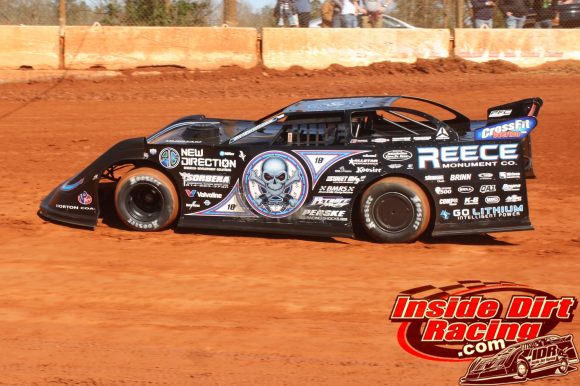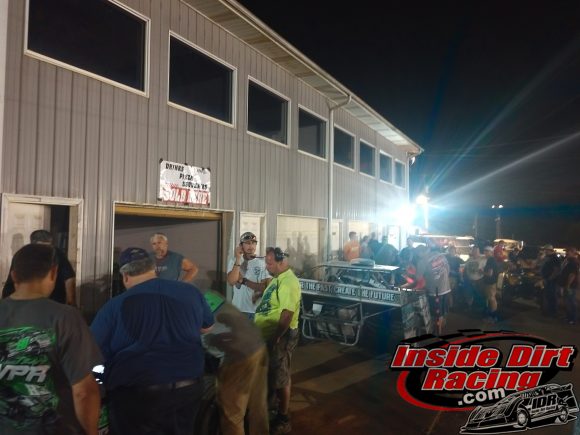*Turn 2 Blog is a regular feature on InsideDirtRacing.com. Here, site operators Michael Moats and Richard Allen take turns offering their thoughts on the dirt racing topics of the day from east Tennessee and beyond.
Richard: As has been widely reported by now, Scott Bloomquist failed to report for a drug test he had been randomly selected for by the World Racing Group during the Firecracker 100 weekend at the Lernerville Speedway in Sarver, Penn. The legendary driver said he had already returned to his Pittsburgh-area hotel after a spin and poor finish in his Friday night heat race and did not think the drug test would be required since he wouldn’t be competing for the remainder of the weekend.
It was the second such test he had missed after having to seek treatment in an emergency room for an injury to his shoulder after falling while at Eldora Speedway during the Dirt Late Model Dream event.
WRG regarded Bloomquist’s failure to show up on Friday night in Pennsylvania as a “refusal” which they equate to a test failure. The result was a suspension levied by the World Racing Group applicable to any event sanctioned by either the World of Outlaws Late Model Series or UMP bodies. However, the leader of Team Zero would be eligible to race in events sanctioned by the Lucas Oil Late Model Dirt Series or any other series or track that is not affiliated with WRG.
All of this may be meaningless anyway due to the fact that Bloomquist is expected to have surgery to correct an ailing rotator cuff in his shoulder. That surgery and its pending recovery will likely keep the 54-year-old out of all racing for some time.
All of that leads me to a question. Whenever any racing organization such as WRG issues a penalty against a driver, as is the case for Bloomquist and his missed drug test or Bobby Pierce for his failed tire sample from Eldora, should it be recognized by other sanctioning bodies?
In other words, is it time for all the national and regional series to present a unified front whether it be related to drug testing, tire doping, unapproved modifications to other parts of the car, fighting, or any other reason?
Michael: I liken this to what our area tracks have done regarding fighting. Most have come together to say if a driver is caught fighting at one track and gets a suspension, all other participating tracks will honor that suspension as well. It seems to have worked well to this point.
Regarding a tire test, that is not as cut and dry. Each series uses a different lab and have different procedures in terms of collecting tire samples. In a recent conversation I had with one of the Lucas Oil officials, he said they are careful not to collect a sample from a car that has driven through fluid that has come from another car. The official said chances are the test would show tampering with the tire. I do not know the policy of World of Outlaws or any of the regional series regarding this. Since so many factors can be different, it’s hard for anyone to say a failed tire test should be applied across the board.
Drug testing is more cut and dry, but still not absolute. We have heard many times of professional athletes that have had a failed drug test and had the player claim an over-the-counter medication caused the false positive result. The same could be applied here for drivers. I’d be willing to bet most Dirt Late Model drivers don’t know what types of over-the-counter medications could cause a false positive. In other words, have a blanket suspension for a failed drug test from another series is not something they want to do.
Refusing to take a drug test is a different animal. Everyone assumes guilt for failing to take a drug test. Just look at what it’s done to Justin Rattliff’s racing career since he refused to take a drug test. He’s had a dark cloud over him and hasn’t raced much since then.
Richard: You make a good point about the uniformity, or lack of uniformity, among the different series when comes to some aspects of rule enforcement.
I love the fact that there is more than one national touring series and that there are multiple regional series out there. It gives more fans a chance to see racing at a high level and it gives more drivers and teams a chance to race at a high level on a given night. And I don’t believe that every rule has to be exactly the same from series to series. However, it would be nice if they could come together on a few of the basics such as tire tests and drug tests.
If the two national series were unified in those basic arenas it would almost certainly have a trickle down effect to the regional tours as well. And by doing so, it would make it easier to educate the participants regarding some of things you mentioned such as how the lab process works in regard to tire testing or what over-the-counter drugs can bring up a red flag in a drug test.
Do you see it the same way regarding uniformity in the most basic of issues?
Michael: Well, I do. There is a little of that in place regarding some of the rules on the cars. We have seen a national committee formed that oversees such things. I think the same could, and should, be done for things like drug testing and even tire testing.
It looks bad when a couple of drivers from one series can go to a place like Eldora and fail a tire test, but never fail in a tire test in the series they run. It looks bad all sides. Obviously, the driver has been branded as a cheater by the most vocal of fans. Then it makes it look as though either one series isn’t as strict on tires as the other or one series is out to get drivers from the other. While neither may be true, it’s the perception among fans and some competitors. We know the old saying about perception being reality. That certainly applies in these situations.
Richard: I teach Psychology and I always tell my students when we talk about perception that it is reality, even when it isn’t. And you’re exactly right about the perceptions people have when it comes to rule enforcement. Whenever a driver gets busted by the organization he doesn’t regularly compete with, there are going to be cries that that sanctioning body is out to get the “outsiders” or that the other sanctioning body lets their racers get away with things and thus they get caught when they go somewhere else to race because they were getting away with it on their normal tour.
Getting back to the Bloomquist situation for a moment, the World Racing Group really had no option but to take the action they did. It was one thing for the driver to miss the first test but to miss it two times in a row was something they had to take move on.
And as far as Bloomquist is concerned, again, perception is going to be reality. No matter what the case, people are going to assume guilt because that’s just human nature when a test is missed.
It really was a no win situation for all involved, wasn’t it?
Michael: I will say this. If this had been any other driver, I don’t think the perception would be as bad for two reasons. One, Bloomquist is such a polarizing figure that he will bring out the worst comments from fans who do not like him at all. But second, and more importantly, his prior drug arrest over 20 years ago just adds fuel to the fire that people will accuse him of still using. That’s just the way some people are.
In the short term, I’m anxious to see how the lack of Bloomquist racing affects the events where people know he would have been if not for the suspension and the surgery. He has so many fans, so, do they still come out to see the racing or stay at home because their guy isn’t racing? That’s the question many promoters are asking themselves right now.
Richard: Yes, that is a major question everyone in the sport will be asking in the near term.
And now to change the subject completely. I want to give a shout out to 411 Motor Speedway following this Saturday’s J.T. Kerr Memorial race that paid $4,000 to the winner of the Crate Late Model feature. Often times when I leave an unsanctioned crate race I have to wonder if everything was on the up-and-up because that division is somewhat known for “working in the gray areas”. However, track owner Mitch McCarter took to social media well before the race to let competitors know that the tech inspections before and after the feature would be extensive.
And then, the track followed through with the warning by inspecting the cars throughout the night and following the race.
If a track is going to have a big race that isn’t sanctioned by a particular series, 411 provided a model to follow.
Michael: That is right, particularly with Crate Late Models and Limited Late Models. Typically, when a track runs a big unsanctioned crate race, there isn’t much in the way of checking engines after the feature. I applaud 411 for taking these measures to make sure whoever won the race was on the up-and-up.
I see less and less inspections of cars in all divisions these days. It’s gotten to be quite a joke in a number of places across the country. We hear stories of the second place driver wanting to protest the winner and the tech director or track owner telling the protesting driver to keep his money or they don’t do protests. There are numerous reasons given for this, but none hold any water in my book. I’m glad 411 doesn’t look the other way.










